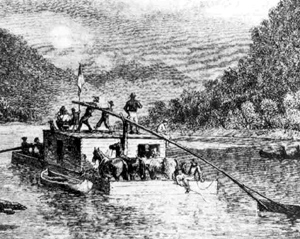Our third option for the Seale family to travel to Mississippi was by river. Traveling on rivers was the longest way to get to your destination because you had to follow the path of the river, which isn’t exactly straight. Sometimes the river would flow the opposite direction from your destination. If Joshua took this route, he and his family would have to travel about

200 miles Northwest to the Holston River in Northwest Tennessee.[1. “Early Migration Routes”, Roots-Web, (http://freepages.genealogy.rootsweb.ancestry.com/~passages/Migrations.html : accessed June 6, 2017).] Once there, they would have built a Flatboat, and floated down the Holston River to the Tennessee River at present day Knoxville, down the Tennessee to present day Huntsville, Alabama, back north on the Tennessee river to the Ohio River at Paducah, Kentucky, and then to the Mississippi River and south to New Orleans.[2. Aubrey Smith, “Early Migration Trails”, Genealogy.com, surname forum, July 11, 2004 (http://www.genealogy.com/forum/surnames/topics/melungeon/13131/ : accessed June 11, 2017).] Not exactly a direct route.
The primary advantage to taking this longer route was the Flatboat. As you can see in the picture, flatboats were not exactly a sleek, modern mode of transportation. You were basically in a big wooden box that was drifting along with the current.[3. “Roads and Rivers”, Tennessee 4 Me, (http://www.tn4me.org/article.cfm/a_id/249/minor_id/79/major_id/25/era_id/3 : accessed June 11, 2017).] The advantage of this box was that it was made of heavy timber, so it shielded its passengers from outside attack. It also afforded a small cabin and a place for any livestock.[4. Seymour Dunbar, A History of Travel in America (Indianapolis: The Bobbs-Merrill Company, 1915) 284-285.] People traveling in this manner would purchase guidebooks, which would plot a suggested course downriver, if you could get the boat to cooperate! You could also hire a guide to help steer the craft through the more dangerous stretches of river.[5. Seymour Dunbar, A History of Travel in America (Indianapolis: The Bobbs-Merrill Company, 1915) 278, 292.] The river portion of this trip could take 5 months or more, depending on the time of year and any stops along the way.[6. Susan Douglas Wilson, “Transportation in Early Middle Tennessee”, US GenWeb Project, (http://www.rootsweb.ancestry.com/~tnsumner/mdtntran.htm : accessed June 11, 2017).]
I know you are asking yourself, how did Joshua get to Mississippi? The truth is, I have no proof, evidence, or any other documents that tell me how Joshua and his family made the trip. My guess is the Flatboat. People who could not afford it made the trip on foot. As we have seen, Joshua had recently sold his property in preparation for this move, so he could afford to build a flatboat and make the trip down river. The flatboat would also afford the family protection from the people and the elements, and give the children a confined place to play on the trip. They would also be able to bring the livestock they would need to begin a new life in Marion County. There are also published rumors that the family spent time in Franklin County, Tennessee, which if true would be right on the way.
Regardless of how they got there, he and the family arrived in Marion County by 1812. We’ll check in on our new Mississippians next week!